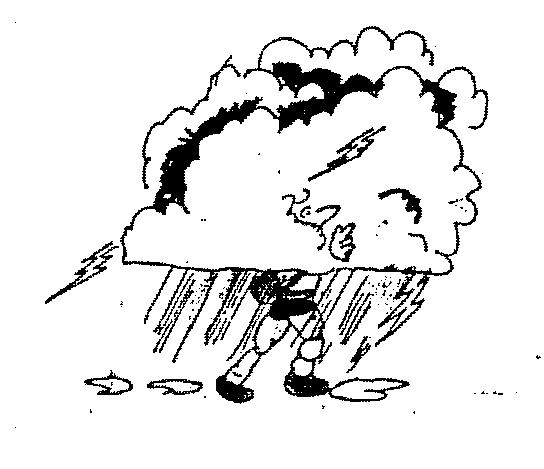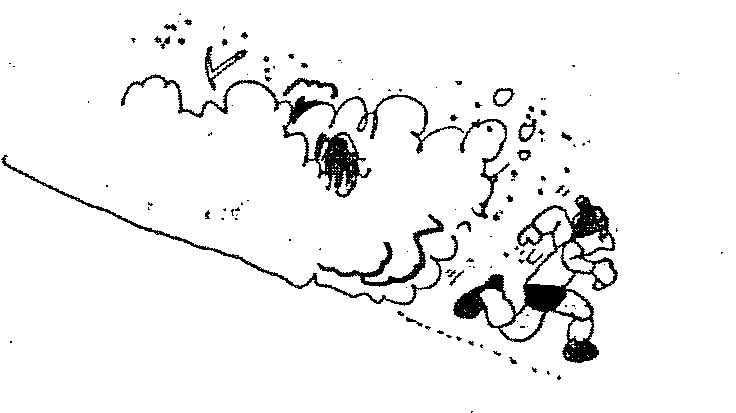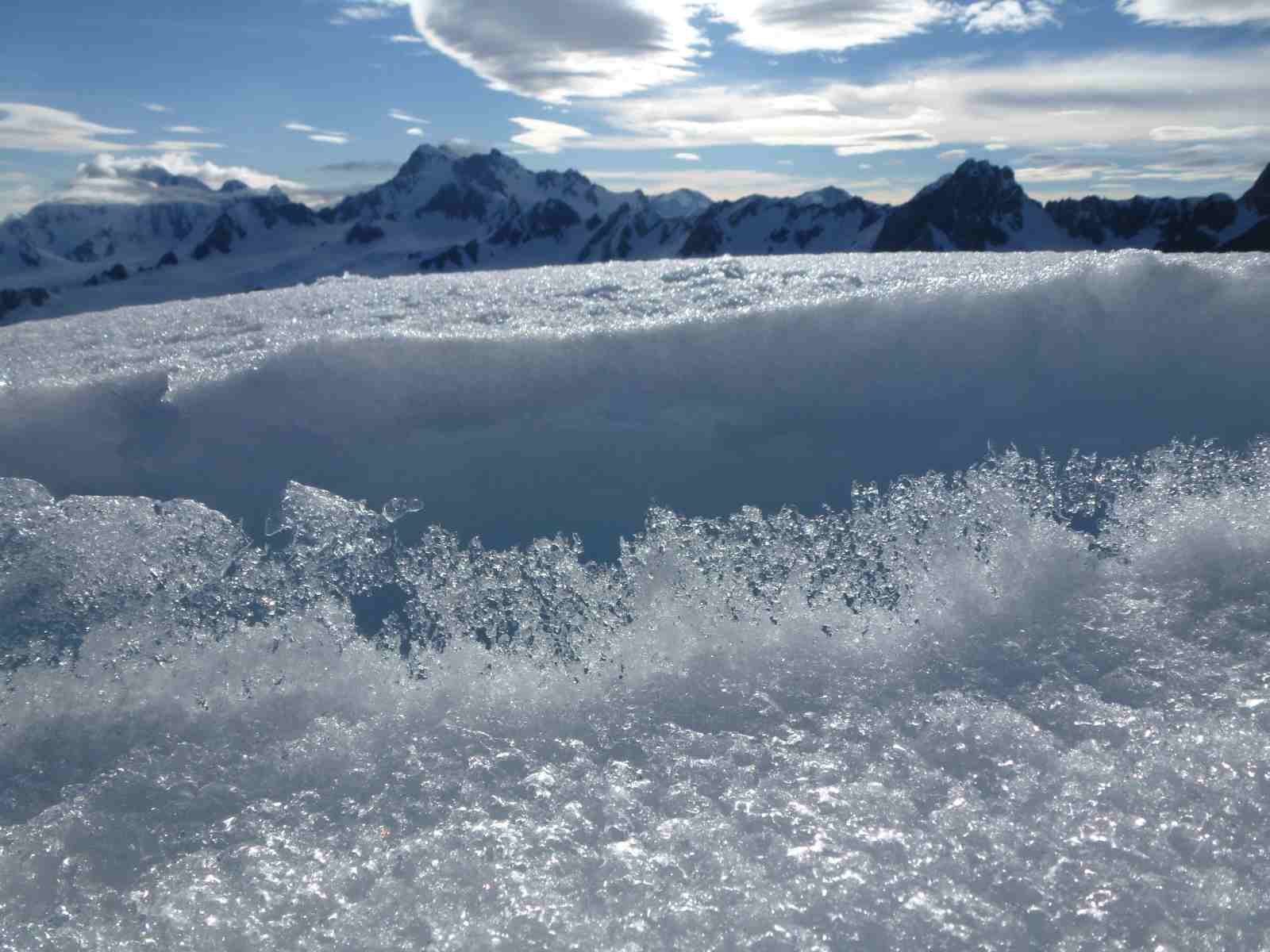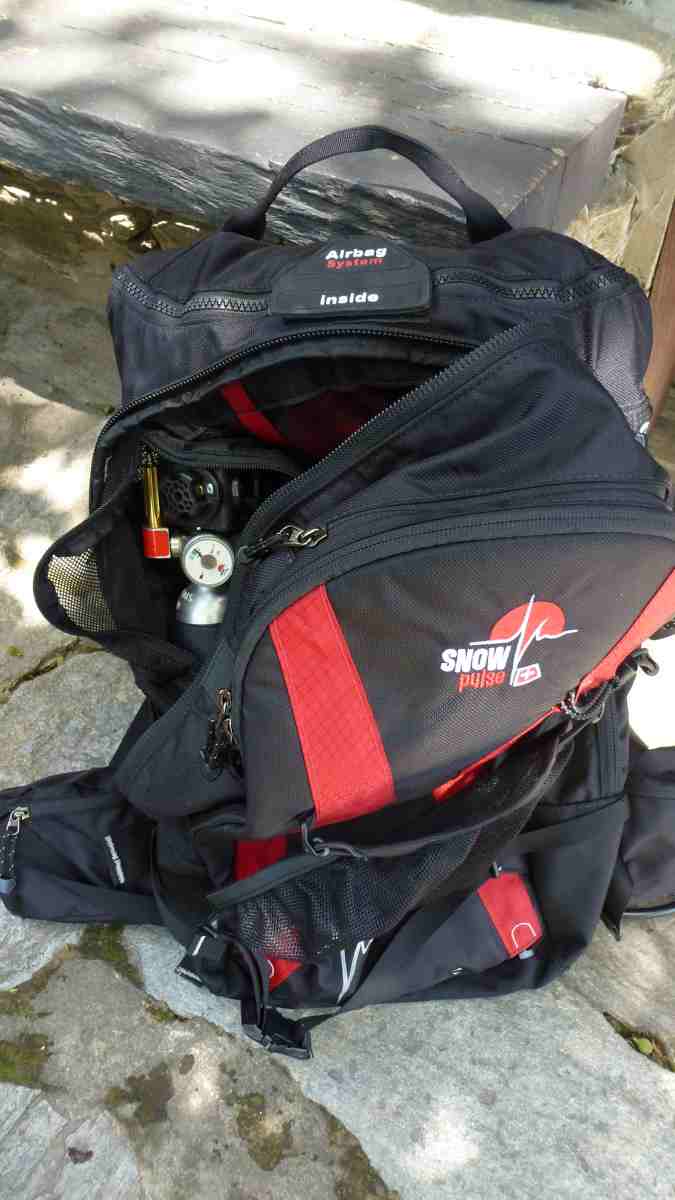
|
| Upcoming Expeditions |
||||
Weather & Avalanche Notes
© Geoff Wayatt - MountainRec., Member: Canadian Avalanche Assoc. (1987-2022)

©Geoff Wayatt, Mountainrec |

©Geoff Wayatt, Mountainrec |
-
Winter Avalanche/Spring Ice caves in Shovel Flat photo
-
New Developments in Search & Rescue Eqt/IKAR -video link
-
Avalanche Rescue Airbag - Snowpulse
-
Sno-Quiz: How many different Snow Flakes are there? Answer below.
11-03-13: Recommended Winter Blog site:
http://utahavalanchecenter.org/
The Utah Avalanche Center, run by Bruce Tremper, is a great source of current avalanche information and discussion. Check out their Blog on Air-Bag survival statistics. The bags are effective tools, but the survival statistics used by various sources overstate their value.
Extract from Blog by Bruce Tremper.
"My pet peeve with this issue is that people who argue about the numbers often leave the most important part out of the discussion--terrain. If you get caught in un-survivable terrain then, guess what, you won’t survive no matter what kind of rescue gear you use. There have been a number of prominent accidents in which the victim with a deployed airbag died because he was either strained through thick trees and rocks, deposited in a terrain trap, buried deeply or went over a cliff. In zero-tolerance-for-error terrain, airbags don’t work, beacons don’t work, Avalungs don’t work. Nothing works. Save your money, buy a life insurance policy and a beacon or RECCO so rescuers don’t have to spend all night probing.
So at least for me, unless I’m 99.9 percent certain that the slope won’t slide, then I don’t go to un-survivable terrain. If I’m going to spend the money and carry the extra weight of an avalanche airbag pack, I want to ride in terrain where it has a chance to make a difference. In other words, choose terrain with no obstacles, no terrain traps or sharp transitions and avoid large avalanche paths.
The other part of the discussion is the often-overlooked issue of what we call “risk homeostasis.” Each gizmo we buy to increase our safety usually cause us to increase our level of risk at the same time. For instance, when we added seat belts and airbags to cars, yes fatalities decreased, but it also allowed us to drive faster, farther, crazier and talk on our mobile phones at the same time. So safety measures usually work but not nearly as well as we would hope because people just increase their risk (and “utility”) at the same time. In avalanche airbag case, we will also get more powder, more fun, and more risk in the bargain.
Bottom Line:
Ignore the 97% number and the 3% number. My best guess is that avalanche airbag packs will probably save a little more than half of those who would have otherwise have died in an avalanche. They will never save all of them because 1 out of 4 will likely die from trauma of hitting trees and rocks on the way down and an additional 1 out of 4 will probably end up in a terrain trap (deep burial), buried by a secondary avalanche or caught in an avalanche that does not travel far enough for the inverse segregation process to work (larger objects rise to the surface).
In addition, people will increase their exposure to risk because of the perception of increased safety, which will cancel out some, but not all, of the effectiveness of avalanche airbags.
As usual, our choice of terrain is far more important than rescue gear. Un-survivable terrain will always be un-survivable. In terrain with few obstacles, terrain traps, sharp transitions and smaller paths, avalanche airbags have the potential to save significantly more than half of those who would have otherwise died. And that sounds pretty good to me."
I would love to hear your comments: http://utahavalanchecenter.org/email-bruce-tremper
Postcard from the Avalanche Edge
2012 Ski Touring tips by GW
WINTER TOURING TIPS from Geoff Wayatt
Lengthen the life of Adjustable Ski Poles
When collapsing them for carrying, don’t tighten the locking mechanism and you’ll double it’s life expectancy
Wind some Duct tape around the ski pole, so it’s handy for use if your skin glue fails to stick to your skis.
Squeaky Bindings?
Ever encountered the irritating repetition of squeaky ski binding when climbing a long arduous slope?
Solution: Silence them with a quick squirt of suncreme.
Weather
Red Sky at Night – a Ski Tourers delight?
This denotes no cloud and clear skies out on the horizon.
For anticipating an even longer “fine weather window” watch for a purple hue progressively and slowly deepening in colour.
Luna-tic weather predictions based on the Moon/tidal effect?
Weather Forecast Tip: Ignore Ken Ring’s predictions and beliefs. They aren’t backed by proven science.
Why? In brief - Water is 700 times more dense than air, therefore the Moon’s effect will be 700 times less on our air mass and weather patterns.
Where? Go to the NZ Met Service Rural Outlook for a brief 7 day forecast for cloud, precipitation, temperatures and wind (all on 1 page)
Weather Clearance? Using your barometer for wx prediction
You get a clearance after a storm. How long will it last? If your barometer does not rise above 1,000hp (sea level) then the clearance may not last very long. The just past front may be quickly followed by another front and storm. Only time for a shorten tour and turn for home while visibility lasts?
Avalanche Precautions
Avoiding burial?
Current stats indicate that a group with a female in the party is less likely to ignore obvious avalanche danger signs and avalanche advisories.
Take note: All 20 - 30yr old single males who are the statistically the high risk group.
Newly available Avalanche Airbags limit your chances of deep burial and greatly improve survival rates (at a cost of $1,000 +) In a few years they will be as common as Avalanche Transceivers.
Cold Feet? Loosen boots, reduce sock constriction, put a hat on.
Cold Hands? Do rapid “aero-plane propeller” arm swings to increase blood flow.
Cold Body? Bulk up with down jacket or food.
Remember Bergman’s Rule! Animal size increase as latitude increases. i.e. Polar bears and Emperor penguins.
Being found?
Carry dog biscuits in your pocket and you might be a higher priority find for an alpine search dog?
Avalanche Transceivers & Cell Phones
Cell phone electronics can interfere with Transceiver searches, so turn them off
New Safety Technology – AirBags
Balloon News: The latest and most innovative safety item since the transceiver is now available:
The Avalanche AirBag is a pack with an air cylinder and buoyancy balloon which inflates when triggered, to wrap around your shoulders and head. It’s been 30 years in R&D and costs over $1,000+, but the technology has now been proven and their survival success rate is very high. I just bought one from Snowpulse. www.snowpulse.com

Winter avalanche debris in Shovel flat photo: GW Nov.2011
Evidence of avalanching? The ice caves in the Matukituki were first recorded by Maud Moreland in her classic turn of the century book "Travels through South Westland"

Surface Hoar on Von Bulow, Franz Josef Glacier Dec.2011
Formed by water vapour transfer, sublimating onto snow crystal branches when temperature very strong (excess of 1degC/10cms.)
(see Franz/Fox Expeditions - Mt. Aspiring Treks)
New developments on Avalanche transceivers and cliff rescue - GW
IKAR (Recent Sweden Workshop)


Snowpulse, Avalanche survival AIR Bag
In 2011 Geoff purchased a Snowpulse AirBag for work safety in avalanche terrain and emergency SAR ops. The technology has been over 30yrs in development following the avalanche death of a young Italian skier, who's wealthy family set up a research fund to find devices to prevent avalanche burial (the concept of the Airbag). Geoff saw the AirBag at a recent Avalanche Conference and was so excited by the Snowpulse unit, that he bought one.
AVALANCHE FLOTATION DEVICES by WorkSafeBC (extract from CAA magazine by GW? Can. Aval. Assoc.
1. ISSUE
In the Coroner’s Report into the deaths of Ms. Kimberly Anne Manchip and Mr.
Daisuke Matsui, both of whom were caught in an avalanche and died from
asphyxiation, the Coroner found that evidence from the incident pointed to the
lifesaving potential offered by avalanche flotation devices. The Coroner
recommended that WorkSafeBC “evaluate the efficacy of avalanche flotation device
use by workers whose workplace involves frequent and extensive exposure to
conditions which may result in life-threatening avalanches.”
Existing literature on avalanche flotation devices has been reviewed in order to
evaluate the performance of these devices.
2. LITERATURE REVIEW
2.1 Avalanche Fatalities
In the majority of avalanche fatalities, the fatality is due primarily to asphyxiation.
Data from Canada, the United States, and Europe indicate that asphyxia
accounts for up to 70-80% of avalanche deaths.1,2 Asphyxia has been found to
occur rapidly after burial. Time to recovery, therefore, is a critical factor in
regards to survival. In cases of complete burial,3 92% of victims will be found
alive if recovery is accomplished within 15 minutes; however, the survival rate
drops to 30% at 35 minutes after burial.4
Depth of burial is another critical factor with regards to survival; the probability of
a live recovery decreases as depth of burial increases.5 The chance of survival
in the case of complete burial has been found to be only about 50%, whereas the
survival probability of not or partially buried people has been found to be
approximately 97%.6
2.2 Avalanche Flotation Devices
Avalanche flotation devices aim to prevent asphyxiation by reducing the depth of
burial in the event of an avalanche. These devices are designed to increase
flotation, keeping the wearer at the surface of the avalanche, and thereby prevent
or minimize burial.
1 Boyd, J. et al (2009) at 509
2 Radwin, M.I. & Grissom, C.K. (2002) at 144
3 Complete burial is defined to mean that the victim’s head and chest are covered with snow.
4 Falk, M., Brugger, H., Addler-Kastner, L. (2001) at 140
5 Radwin, M.I. & Grissom, C.K. (2002) at 144
6 Tshirky, F., Brabec, B., & Kern, M. (2000) at 2
Reference List
1. ABS Avalanche Airbag System. ABS Facts. Retrieved July 27, 2009 from
http://www.absairbag.
com/abs_fakten.php?chid=1249&m=18&lang=us&sid=d1283a73e67b413f67d
76f84a17a4bbf.
2. Boyd, J. et al. (2009). “Patterns of death among avalanche fatalities: a 21 year
review.” Canadian Medical Association Journal 180(5): 507-512.
3. Brugger, H. and Falk. M. (2002). Analysis of Avalanche Safety Equipment for
Backcountry Skiers. Retrieved July 24, 2009 from
http://www.snowpulse.ch/v3/medias/brugger_falk_report.pdf.
4. Brugger, H. et al. (2007). “The impact of avalanche rescue devices on survival.”
Resuscitation 75: 476-483.
5. Falk, M., Brugger, H. and Adler-Kastner, L. (2001). “Calculation of survival as a
function of avalanche.” Wilderness and Environmental Medicine 12: 140-141.
6. Hohlrieder, M. et al. (2007). “Pattern and severity of injury in avalanche victim.” High
Altitude Medicine and Biology 8(1): 56-61.
7. Kern, M., Tschirky, F and Schweizer, J. (2002). “Field tests of some new avalanche
rescue devices.” In Proceedings of the International Snow Science Workshop,
Penticton, BC, Canada, September 9-October 4, 2002. Retrieved July 24, 2009 from
http://www.snowpulse.ch/v3/medias/essai_davos_en.pdf.
8. Radwin, M.I. and Grisson, C.K. (2002). “Technological Advances in Avalanche
Survival.” Wilderness and Environmental Medicine 13: 143-152.
9. Scrivener, L. (2008). Of airbags, Avalungs and avalanche safety. Retrieved August
7, 2009 from http://www.thestar.com/News/article/293484.
10. Tschirky, F. and Schweizer, J.(1996). “Avalanche Balloons – Preliminary Test
Results.” In Proceedings of the International Snow Science Workshop. October 22
-29, 1996, Banff, AB, Canada. Retrieved July 27, 2009 from
http://www.avalanche.org/~issw/96/art70.html.
11. Tschirky, F., Bernhard, B. and Kern, M. (2000). “Avalanche Rescue Systems in
Switzerland: Experience and Limitations.” In Proceedings International Snow
Science Workshop, Big Sky, MT, USA, October 2000. Retrieved July 24, 2009 from
http://www.slf.ch/praevention/lawinenunfaelle/unfallstatistik/unfallstatistik-en.pdf.
HOW MANY DIFFERENT SNOW FLAKES?
Kate Bush has just released a new music album called:
50 Words for Snow - So how many are there?
Some say "no two crystals are exactly alike!"
I gathered William Bentley, a paraplegic in Vermont in the 1930's, with a microscope and an enquiring mind photographed some 3,000 individual snowflakes. Were they all different?
I don't know.


William Bentley Crystal Photos/From: Fieldguide to Snow Crystals by Ed la Chapelle
However, ages ago, I also recalled hearing from one mountain source, that there were 36 words for snow! My interest was further fuelled by the acquisition of the definitive text by G. Somerville, Snow Structure & Snowfields, 1936 where he described some crystals in english for the first time - the European terms of snow primarily used continental languages.
Were there definitive Inuit words for what we know as needles, stellars, plates and spatial dentrites?
A chance couple of hours in a Nthn. Alberta Library led me to some Inuit Dictionaries which included words for snow. As I looked through the pages I could see my quest for a specific number of different crystals evaporating into another realm of word usage.
The value of the words became more apparent when I later spent more time construction Igloos with Logan Park High School students. The words in Inuit were mostly environment words, such as: "Snow blowing above the knees/or shoulder.
So, my the quest continues on a common topic, but world's apart in application of word useage. GW
Keep fit, Geoff Wayatt
